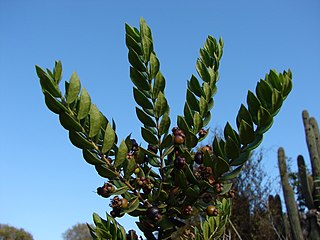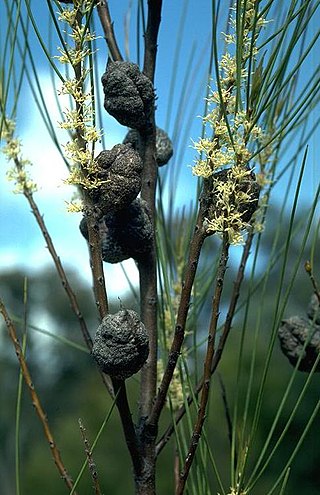
Ugni molinae, commonly known as Chilean guava berry, or strawberry myrtle, is a shrub native to Chile and adjacent regions of southern Argentina. The local Spanish name is murta, and the Mapuche Native American name is "Uñi" or Uñiberry. It is in the same botanical family as the guava.

Ugni is a genus of plants in the myrtle family Myrtaceae, described as a genus in 1848. It is native to western Latin America from the Valdivian temperate rain forests of southern Chile and adjacent regions of southern Argentina, north to southern Mexico.

Luma chequen, the white Chilean myrtle, is a species of flowering plant in the genus Luma in the family Myrtaceae, native to the central Andes mountains between Chile and Argentina, at latitudes located 30 to 41° South. Synonyms include Eugenia chequen Molina, Myrtus chequen (Molina) Spreng., and Luma gayana (Barn.) Burret. Common names in Spanish include chequén, huillipeta, and arrayán blanco.

Myrcianthes is a genus of flowering plants in the myrtle family, Myrtaceae described as a genus in 1856. They are native to Central and South America, the West Indies, and southern Florida.

Myrcianthes pungens, the guabiyu, is a species of plant in the family Myrtaceae. It is native to Brazil and Uruguay.

Phyllanthus anamalayanus is a species of plant in the family Phyllanthaceae. It is endemic to the Anamalai Hills in Coimbatore district in the state of Tamil Nadu, India. The species is a shrub or small tree occurring in the understorey of mid-elevation tropical wet evergreen forests in the Anamalai Hills, and is endemic to the Western Ghats. It is threatened by habitat loss.

Kageneckia oblonga is a species of plant in the family Rosaceae. It is endemic to Chile. K. oblonga is an evergreen tree. It grows from Coquimbo to Malleco. Example occurrences are found specifically found in central Chile within the La Campana National Park and Cerro La Campana forest areas. In these areas the endangered Chilean Wine Palm, Jubaea chilensis is an associated tree species.

Myrceugenia obtusa, also known as raran, is an evergreen tree endemic to Chile from Coquimbo to Cautin. It grows mainly in the coastal mountains on moist sites.

Hakea dohertyi, commonly known as the Kowmung hakea, is a shrub endemic to a restricted locale in the Great Dividing Range in central New South Wales in Australia.

Olearia paniculata, commonly called akiraho, is a species of shrub or tree in the family Asteraceae, found only in New Zealand. The tree can grow to 6 metres high, and has yellow-green, oval-shaped leaves, with white undersides and wavy margins.
Myrceugenia rufa is a species of shrub in the genus Myrceugenia of the family Myrtaceae. It is endemic to Chile, where it grows in forest remnants near the coast and is considered "endangered".
Myrceugenia colchaguensis is a species of small evergreen tree in the genus Myrceugenia of the family Myrtaceae. It is endemic to Chile where it is found in the coastal mountain range at altitudes below 400 m (1,312 ft). Common names by which this tree is known include colchaguillo, arrayan de colchagua and lumilla.

Myrceugenia leptospermoides is a species of small evergreen tree or large shrub in the genus Myrceugenia of the family Myrtaceae. It is commonly known as mocollo, murtilla del malo or chequen. It is endemic to central Chile where it is found in riverine habitats in the coastal mountain range at altitudes below 300 metres (980 ft).

Melaleuca glauca, commonly known as Albany bottlebrush is a plant in the myrtle family, Myrtaceae and is endemic to the south-west of Western Australia. It is a tall shrub with glaucous leaves and spikes of red flowers in spring.
Melaleuca hemisticta, commonly known as Mount Wheeler bottlebrush is a plant in the myrtle family, Myrtaceae and is endemic to coastal areas of Queensland. It is a tall, bushy shrub with dark green leaves and red flowers spikes tipped with yellow.

Melaleuca megalongensis, commonly known as Megalong Valley bottlebrush, is a plant in the myrtle family, Myrtaceae and is endemic to New South Wales.. It is a shrub similar to Melaleuca citrina which occurs in the same area and is difficult to distinguish from it, except when in flower.

Melaleuca wimmerensis, commonly known as the Wimmera bottlebrush, is a plant in the myrtle family, Myrtaceae and is endemic to the state of Victoria in Australia.. It is a recently (2008) discovered shrub, often with many stems arising from a lignotuber and is similar to Melaleuca paludicola but has pink or mauve flowers tipped with yellow anthers over a short period between October and early December.

Eugenia myrcianthes or ubajay is a species of plant in the family Myrtaceae found in Argentina, Bolivia, Brazil, Paraguay and Uruguay.

Myrcianthes rhopaloides is a shrub or tree in the family Myrtaceae. It is native to North and South America. Edible Fruit.
Drypetes gerrardii is a species of small tree or large shrub in the family Putranjivaceae. Common names include forest ironplum, bastard white ironwood, and forest ironwood. It is native to tropical and subtropical central and eastern Africa. It was first described in 1920 by the English botanist John Hutchinson, who named it after the English botanist William Tyrer Gerrard who collected plants and seeds in southern Africa in the 1860s.















